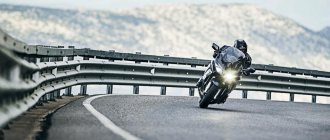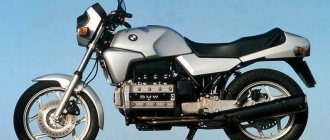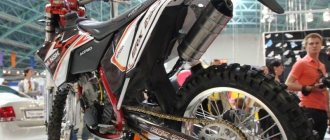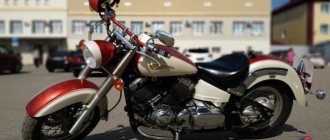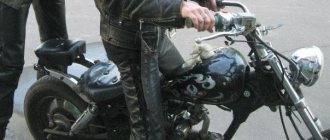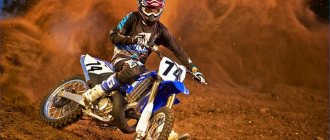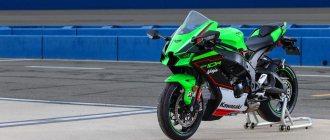This motorcycle was intended to replace the Zephyr 750 from the same concern, however, oddly enough, it ceased production a year earlier than the famous classic model. Having existed on the market for only six years, the bike was never able to live up to the hopes of the designers, and there are a number of reasons for this.
This is a standard road bike. Many people are too used to naked road bikes, and they are certainly not too impressed with an option like the Kawasaki ZR-7. However, overall the motorcycle turned out to be quite good.
001_0210_028
Kawasaki ZR-7, neoclassic, 2001, 738 cm3, 76 hp, 170,000 rub.
Kawasaki ZR-7, neoclassic, 2001, 738 cm3, 76 hp, 170,000 rub.
When I first saw the ZR-7 - with its fast, light plastic shapes, huge brake discs and a hefty muffler "can" - I was amazed by its beauty and athleticism - like a street fighter! The design of this “quack” cannot be compared with the axe-hewn Honda CB750 or the inconspicuous Yamaha XJR1200. The only detail that stands out somewhat from the overall appearance is the power unit. A hefty “row” of air-oil cooling, richly striped with cooling fins and replete with right angles surrounded by smooth bends of the linings, it looks like an alien from the past (and, by the way, it is, but more on that below). But overall the device is perceived very harmoniously. The appearance of the “zeerka” makes it similar to the more modern generation of neoclassics, such as the Honda Hornet, Yamaha Fazer or Suzuki GSR600. That is why, from the first glance at him, I expected extraordinary agility, sharp control and a hooligan character.
Pros and cons of the Kawasaki ZR-7
Kawasaki ZR 7 has the following advantages:
- Comfortable seating position that will suit most people.
- Powerful engine (73 hp).
- Easy gear shifting. Finding neutral is quite easy.
- An oil cooler mounted quite high. The component is well protected from contamination.
- Comfortable seating.
- Comfortable location of control devices (buttons and suction control directly on the steering wheel).
- Ergonomic steering wheel.
- Elaborate design of mirrors.
The model also has minor drawbacks:
- Stiff suspension. At low speeds, vibrations from uneven road surfaces are felt very strongly.
- Tubeless wheels on alloy wheels. Flying into holes and bumps at high speed is highly not recommended.
- Lack of wind protection.
- Low low beam coverage.
002_0210_030
Kawasaki ZR-7.
Kawasaki ZR-7.
The same emotions are evoked by the position that the motorcycle invites the pilot to take: the “sofa” is moderately hard, quite wide and well-profiled; the footpegs, although not very high, are set slightly back and, together with the rather narrow steering wheel, form a slightly more comfortable seating position. but with a noticeable tilt forward. The pose does not make you want to bury your chin in the gas tank, but the roadster notes in the landing are obvious - it encourages you to “zig.” By the way, for me, 188 cm tall, the saddle is quite spacious: my knees fit into the stampings provided for them in the sides of the gas tank, and my feet found the footrests themselves. The upper body is also comfortable: the steering wheel is not far - not close, not high - not low - just right. The controls are located absolutely traditionally and fit your fingers as usual.
Owner reviews
According to owner reviews, the Kawasaki ZR 7 model was highly appreciated. Among the shortcomings, the most often mentioned are low beam and lack of wind protection. Driving this model in rainy weather is not the best experience. Users noted the high build quality (the motorcycle is extremely resistant to wear if the rules of operation and storage are followed), convenient control (the weight practically does not cause problems with controlling the bike when turning and maneuvering in traffic), and a good cooling system.
005_0210_030
The classic layout of the tidy is refreshed by white dials.
The classic layout of the tidy is refreshed by white dials.
While I was looking at the instruments and buttons, the engine was warming up, clearly, but not intrusively, rumbling its insides. The test motorcycle is equipped with a tuning exhaust system with a direct-flow “end” that produces a very pleasant and moderately loud sound - just right so as not to get lost in the traffic, but also not annoying on long hauls. Even this “amplifier” could not hide the noise of the engine itself - nevertheless, the “airs” are always “talkative”. In general, the sound turned out to be very rich and noble - in any case, there is a feeling of a “big iron” motorcycle, and not a “plastic coffee grinder”.
History of changes
During its development, this motorcycle has undergone a number of changes:
- 1998 - first appearance in the world, at the Munich Motor Show;
- 1999 – start of sales;
- 2001 – modification ZR-7S appeared;
- 2005 is the last year of production.
Even if the bike was not able to attract many with its characteristics and performance, its design was a great success. Even now, someone can be impressed by its simple but at the same time elegant shapes. This kind of exterior occupies an intermediate position between classics, nakeds, sportbikes and cruisers.
008_0210_030
The sound of the tuning “can” is not annoying with volume, but allows you to remind yourself in the flow.
The sound of the tuning “can” is not annoying with volume, but allows you to remind yourself in the flow.
Literally half a minute after the start, you can turn off the choke and get underway. I roll out of the yard, and this is where the inconsistencies in appearance and essence begin. The clutch works predictably and softly, but the clutch moment is spread over the length of the lever stroke. It’s strange, because usually the evil naked ones have it much sharper and clearer (am I definitely on a ZR-7, or did I get on a chopper by mistake?). I slowly roll along the Moscow streets, not yet clogged with evening traffic jams, switching gears, and again I am surprised: the clarity of the gearbox is almost perfect. The force on the foot is minimal, the stroke is small, and the gears are engaged unambiguously and quickly, without false neutrals and misalignments - unlike the “gear box” on some “Zizer” from the mid-nineties. Kawasaki has done serious work on bugs! The engine pulls quite smoothly from the very bottom, pleasing with a noticeable pick-up around 4500 rpm, the suspensions conscientiously absorb small and medium-sized irregularities, and handle large waves and ruts gently, without shaking the soul out of the pilot. In a word, the comfort in a quiet driving mode is such that you don’t want to go faster. Unfortunately (or maybe fortunately), not all of our lives are a walk, and not all roads are sleepy streets of residential areas. Someday they will end. I pull out onto a busy avenue and unscrew the handle to quickly join the traffic moving at a speed of over a hundred. At this very moment, that same abstrusely incomprehensible state mentioned in the title covers me completely and irrevocably. “Quack”, instead of shooting up to the speed of the flow in a matter of seconds, enthusiastically howling its insides, begins to slowly accelerate, like a train departing from the platform. It’s starting to feel a little uneasy - there are already trucks backing up behind us, and the “blue frog” and I can’t get into the flow! It’s clear that there was a pilot’s mistake, that is, mine. I overestimated the capabilities of the motorcycle, buying into the athletic appearance and impressive displacement, but the engine was not like a sportbike. While I was worried about such an unforgivable oversight, the tachometer needle reached o, and then a miracle happened - as if someone big and heavy (but a truck that had not caught up, for sure!) gave a weighty kick, and further acceleration became comparable to the ¾-liter modern engine. In general, there is nothing surprising in this behavior of the motorcycle. If you don’t lower the tachometer needle below 6000–7000 rpm, you can accelerate quite dynamically, however, all the engine’s already rather late-awakening enthusiasm fades closer to 8500 rpm. Although the red zone of the tachometer begins at almost 10,000 rpm, you literally have to work with the gearbox, catching the most efficient modes. What lies behind such a “cunning” characteristic of the engine? It's simple: the model was released in 1999, and was developed from a “clean slate” - that’s where such modern shapes and the swiftness of the silhouette come from.
But the engine migrated to the ZR-7 from the Z750 model already... in 1973! Of course, the engine was seriously redesigned, the cylinder diameter was increased, the piston stroke was reduced, modern ignition and power systems were installed, and even the K-TRIC system (Kawasaki Throttle Response Ignition Control), or simply a throttle position sensor that adjusts the ignition timing depending on their position, but, in fact, it’s still the same old man with two valves per cylinder and a very thoughtful character. This is the reason why the engine spins sluggishly and quickly “dies out”. Two-valve cylinder heads, especially on in-line engines these days, are more exotic than a desmodromic timing drive or V-shaped connecting rods.
But let’s not demand the agility of a panther from an elephant, or the power of something with “RR” at the end from a ZR. Of course, the motorbike allows you to “pult” if you really want to, but 750 “Japanese” cubic centimeters is not a “Dnepr with a cradle”. It reaches a hundred “quack” in just over five seconds, and the maximum speed is quite acceptable - more than 210 km/h, but neither frantic acceleration nor “low flights over the road” are not for this motorcycle. A classic chassis is not a modern aluminum duplex: in fast turns the bike begins to “float” slightly, and the complete lack of wind protection does not encourage such experiments. Obviously, the device was created specifically for riding, breathing evening air through the open visor of the helmet and carrying the owner on daily errands, and not at all for setting speed records and shooting at traffic lights. In general, if you do not demand from a machine beyond its capabilities, you will find a common language with it instantly. In the city chaos, “kvaka” feels like a fish in water. Both the engine and the brakes are more than enough for the pilot to feel confident in almost any driving situation.
In 1983, the KAWASAKI superbike racing team unexpectedly upset everyone. Piloting an aging GPz750 with an eight-valve, air-cooled, four-cylinder in-line engine, pilot Wayne Rainey snatched the Superbike championship from Honda's stunning V45 Interceptor. The Interceptor was hailed by critics and magazine editors as the Holy Grail of performance driving, the car's 16-valve DOHC V-4 engine and Freddie Spencer's design were sure to squash the competition as easily as a man could squash a fly. . In all tests, the Interceptor was faster, handled better and no one doubted that it would take the lead in the championship. Apparently Wayne Rainey, Rob Muzzy and the remaining members of the Kawasaki team didn't bother to read the magazines. If they had done this, they would certainly have left before the start of the season. Instead, the Kawasaki team came together and squeezed every last drop of horsepower out of what some call an "antique" engine design. With Wayne at the wheel, the team won its first championship victory in years. Kawasaki's latest naked power bike: the ZR-7.
With the new ZR-7, Kawasaki has made a move as good as winning the Superbike crown in 1983. The ZR-7 - a naked power bike clearly aimed at street riding - has its roots in the same GPz750 that Wayne Rainey won on title in 1983: it has an almost identical four-cylinder air-cooled engine with 8 valves and a displacement of 738cc, suspended in a steel tubular frame. But that's where the similarities end. The new chassis of the ZR-7 has exactly as much in common with the old GPz750 as a silk handbag and a cow's ear. The ZR-7's chassis is quite modern and features 3.5″ x 17″ front and 5.0″ x 17″ tires, the same size as those on the ZX-6R. The thick front fork, which is quite suitable for racing, is topped by massive 300mm brake discs with twin-piston calipers similar to those found on the VFR. And the rear swingarm, although not aluminum, is made of exceptionally strong steel and has a powerful crossbar that leaves no doubt about the reliability of the entire structure. Of course, hardware alone is not a guarantee of good performance. Kawasaki has provided the bike with excellent handling, on par with the best street bikes, regardless of the number of R, Z or X in their names. The ZR scores points when comparing it head-to-head in street use with any sports bike currently available. When it comes to handling, the ZR leaves all cars in its class, including many sports tourers and standards, far behind.
The ZR-7 inspires exceptional confidence when cornering. Straight from its mother's womb, the ZR-7 has one of the best, if not the best, chassis with the possible exception of the Yamaha YZF-R6 or the late YZF750. Its suspension behaves similarly to that of the Honda CBR600F4 when compared on normal twisty roads, with the same neutral feel at all lean angles and an exceptional ability to soak up road imperfections with its beautifully tuned suspension parts. The brakes are excellent, without the harsh, snappy feel of something like the YZF-R1, but still offer a good amount of variable power that's ideal for the machine's performance potential. That potential is well supported by an engine that might seem anachronistic in an era of carbon fiber, 20-valve cylinder heads, aluminum frames and titanium exhaust systems. It's wider and heavier than even the sub-liter engines of the latest sports rigs, and produces a seemingly mundane 75 horsepower off the crankshaft, exactly the same as a 1985 GPz750. However, this is where their similarities end. Once the road turns serpentine, with equal drivers, any attempt to keep the ZR in sight will leave the GPz pilot twisting, twisting and sliding in a futile tarantella that results in the need to change and sweat out his underwear a few turns later. The ZR's chassis is as modern as its engine is, a clear indication that Kawasaki's engineers have worked into the night to give the bike its beautiful, unflappable handling.
Behavior on the road
The ZR-7's handling at all speeds up to serious knee-scrapers is virtually flawless, even with the supplied Dunlop 205. From tight corners at 20 mph to 100 mph blasts, the ZR-7 handles crisply. It tenaciously holds the line of movement, which does not prevent the driver from making corrections in the middle of a turn without much strain on the suspension or the use of serious muscle effort. With the shocks set to maximum rebound and about two-thirds pre-compression, the car was close to perfection on our unpredictable, winding road in Los Padres National Forest. The frost-blown, rough, zigzag coating did not bother the car at all. One hundred-kilogram, six-foot tester commented that the bike instilled an exceptionally high level of confidence when tackling some tricky, twisty descents in a way that few, if any, machines can do. Even at exceptionally deep lean angles, the suspension and tires rode confidently over uneven surfaces without a hint of wobble or shake. Steering feel is relatively light across the knobs, but without any shake or instability at all reasonable speeds and circumstances. And we have a very broad understanding of the word “reasonable”. Advanced maneuvers like trailbraking are as deft as any of the sports cars we've tried on sale today. Brake your front brakes as deep into the corner as you like: the bike doesn't tend to straighten out very much, remaining neutral all the way to the apex of the corner if you're brave enough to brake that deep on the streets. Give the handlebars a little push while leaning and the bike responds with just the right amount of correction you want. This car seems to simply disappear under the driver, allowing your interaction with the road to be intuitive and well-calibrated so that your attention can be devoted entirely to the ride itself and not to problems with the suspension or engine.
The ZR-7 is the surprise winner in the ease-of-handling war against street stars like the VTR1000, VFR800 and CBR600F4. But why? Like the VTR and VFR, the ZR-7 trail is a little short for the fork angle, which allows it to be quite easy to handle at low speeds. Most sportbikes are designed in this way, which determines the manner in which they are driven in the city and, of course, attracts potential buyers during test raids. However, once the speeds increase to serious, scratchy surface speeds or those achieved on trails during practice days, many sports bikes handle a little harshly. Due to the small trail, the steering feel deteriorates; there is a slight feeling of delay between the movement of the steering wheel and the reaction of the motorcycle. Kawasaki in their ZR-7 implemented a fairly large rake (25.5 degrees) and wheelbase length (57.3 inches) along with trail (3.7 inches). These numbers allow the machine to have the light enough handling required when parking, for example, while still allowing the bike to have excellent stability at high speeds. The same trend follows the SV650 and YZF-R6, which also have surprisingly large trails for their weight and size. However, even though the VFR800 has trail and fork angle virtually identical to the ZR-7, the stability and precision of the VFR800 is worse because it is about 50 pounds heavier and has a half-inch shorter wheelbase. The techs at Computrack say that the stem of the fork can be identified with the rudder of a boat. If the VFR, VTR and Blackbird were boats, they would have smaller rudders which would require more attention and provide less performance and stability than a boat with larger rudders. (The Titanic, for example, fell victim to this problem - its rudder was too small and could not steer the ship away from its fate quickly enough.) The ZR-7's exceptionally reliable and precise handling at high speeds is an element missing from many modern sportbikes, including these known as the YZF-R1 and GSX-R750. While these bikes do a great job of what they're designed to do, that slight lack of precision and stability is the factor that keeps riders accustomed to the stability of race bikes from loving them unconditionally. The ZR, meanwhile, has the confidence-inspiring stability found in the YZF-R6, Ducati 996, FZR400 and YZF750. It zips through high-speed corners with aplomb and navigates switchbacks as easily as any midsize resistance bike. And if the ZR has a beef with Honda VFR owners and can even go toe-to-toe with the R6 and F4 off the track, that means comparing cars like the ZRX-1100, Nighthawk 750, 1200 Bandit, Bandit S and Seca 600 to the ZR-7 knife with gun. These cars start to burst at the seams long before the ZR reaches its limits.
Ergonomics
Double 300 mm discs allow the driver to easily control braking force. An important part of the ZR's sporty driving experience is its near-ideal driving position, which is extremely rare. On the ZR, the driver can have excellent control of the car while enjoying a high level of control. For drivers six feet tall, give or take a few inches, the hands rest on a medium-width steering wheel at an extremely comfortable angle. The footpegs, positioned high enough to avoid scraping the pavement at all but the most insane cornering angles, allow the rider to transfer his weight to what feels very much like the chassis' center of gravity. The driver's body is leaned slightly forward, which places enough of his weight on the front wheel to use his body to control the car's weight distribution during deep mid-corner leans. It appears that the combination of a mid-curve handlebar, slightly aggressive riding position and excellent weight distribution between the front and rear tire contact points puts the rider in the ideal position. Even a slight shift of body weight to the left, right, forward or backward allows you to easily control the machine. The design gives the driver the opportunity to become part of the car without much physical effort.
Power
Kawasaki's famous air-cooled inline-four. Note the stainless steel exhaust system and race-inspired manifold. The ZR-7's inline-four is hardly a powerhouse. Unlike the clunky Hayabusa, the ZR-7 engine can't be used as a backup generator in the event of a Hoover power plant failure. Real-world output is about 66 horsepower and 41 pounds of torque. on the rear wheel (according to European magazines that tested the motorcycle) - just enough for the given chassis design and intended use of the machine. As sold, the ZR-7's engine is incredibly understressed, a characteristic that immediately speaks to the driver's state of mind. The engine is tuned to have a broad, smooth output and pull the car through city traffic without much effort. The ratios in the smooth-shifting five-speed gearbox are tuned to provide excellent low-speed agility without the need for constant clutch slippage, without compromising fuel consumption (more than 50 mpg on the highway). The ZR cuts through traffic with authority and has enough power to handle any urban situation.
The K-TRIC system works depending on the position of the throttle, reducing fuel consumption and improving performance in the mid-speed range. Kawasaki's new naked power bike is every bit as good as its modern rivals, despite its seemingly dated design. The engine is very easy to use and has enough power for a wide range of sporty driving and touring. But it doesn't dominate the driver and doesn't tend to surprise him like many modern superbikes. Power delivery is smooth, predictable and always more than adequate. The new K-TRIC system reads throttle position and uses this information to electronically vary ignition timing to produce better mid-range performance and better fuel economy. For those interested in top speeds, European testers achieved speeds in excess of 130 mph (measured using radar) using the bike without any modifications, straight from the factory. For a bare-faced bike with 66 horsepower, that's impressive; and you'll end up in jail just as quickly as you would with a 190 mph Hayabus.
A large oil cooler cools the oil, thereby extending engine life. Kawasaki's inline-four is known for its reliability, and the ZR-7 should last a lifetime with proper care. It is also extremely easy to maintain and operate, with everything within easy reach. Air cooling means there are far fewer parts to break; In addition, the 750 is equipped with a strong oil cooler to keep temperatures low during long runs on hot days. With frequent oil changes and proper maintenance, this engine will have a long, trouble-free career. For those who can't wait, it should handle the improvements just fine (the old GPz produced 85 horses from the same engine), although reliability and handling may suffer.
Comfort and convenience A proper helmet lock is a nice touch on any streetbike. With a dry weight of 445 lbs (202 kg) and a wet weight of about 480 (217 kg), the ZR-7 is comfortable for fairly long trips. The seat is tilted forward, which can create inconvenience for some drivers, but this problem is easily solved either by purchasing a seat or re-upholstering the existing one. The combination of footpegs, handlebar grips and seat is as close to ideal for a car without trims as it gets - we haven't seen better. This combination places the rider in a slightly forward-leaning position, which allows the wind at normal speeds to support the torso, taking almost all the weight off the wrists. In addition, the driver sits high enough to have a clear view of the road.
The steel pendulum with a powerful crossbar is in no way inferior to its aluminum counterparts on more expensive cars. The suspension components - Kayaba shock absorbers with rebound and preload adjusters at the rear, a pair of 41mm Kayaba pipes at the front - are designed for a soft ride. The riding position, as we have already said, contributes a large part to the high level of comfort and control of the bike. The rider's weight is distributed fairly evenly between the footpegs and seat with no specific pressure points. During long rides, changes in body position and therefore weight distribution between support points should increase the distance covered without stopping. The ZR-7 also boasts some amenities that set it apart from most bikes in terms of long-term purchase. It has a great center stand. It's very comfortable to use, and it's tucked away well enough to avoid scraping the pavement during aggressive turns. The rear pendulum supports and shock absorber connections are equipped with special devices that allow them to be lubricated without disassembling the entire assembly. There is a standard fuel gauge - an extremely useful thing - just as emergency turn signal mode can be useful if you need to change clothes for more suitable ones for the weather at night. The brake and clutch levers are equipped with adjusters so drivers with different hand sizes can adjust them to suit them. The bike has modern 17-inch wheel rims, which allows riders to choose tires from the widest range. Drivers who cruise aggressively on weekends might consider the BT-56 SS-Type or Michelin Pilot Sport, while those who alternate between long highway and switchback runs might opt for the Michelin Macadams or the included Dunlop 205. There's also the Metzeler. MEZ4, Dunlop 207, and so on. The machine is extremely customizable and can be adapted to the individual needs of a wide range of drivers. The standard handlebar and lack of fairing allows you to choose from a huge number of windshields, which greatly help against June bugs, wet weather and cold air. The tank is wide enough to accommodate a tank bag large enough to hold enough provisions for a long weekend. For longer trips there are a variety of options available - soft and hard luggage cases from GIVI, and quarter-panel from Targa will be available by the end of 1999. The ZR is equipped with special mounts for GIVI products, which should make installation of the cases easier. Equipped with a small fairing and saddlebags, the ZR is the perfect single or two-seat tourer you can dream of.
Competitors
The ZR-7 is designed for a broad market niche - standard motorcycles. Formerly known as UJM (Universal Japanese Motorcycle), now called naked, they have the following idea: these bikes do everything well enough, but without much flair. Manufacturers adhered quite strictly to this feature for their “standard motorcycles”. There are plenty of these cars out there—some still in production—trying to satisfy the average driver by delivering unremarkable performance. In discussing the large number of standards that have been proposed over the past decade, we have come to an interesting conclusion: literally every one of them had serious governance problems. Here is our partial list of contenders for the throne and our arguments that the throne belongs to Kawasaki:
Honda Nighthawk 750
750cc standard, the Nighthawk features a water-cooled 750cc inline-four with unique self-adjusting valves. With 62 horsepower and 41 pound-feet of torque, the engine appears to be in the same weight class as the ZR, but delivers far less power. The heavy flywheels contribute to a lazy, lackluster power delivery that just falls short of the "intimidating" bar. The strange choice for the diameter of the wheel rims does not leave much room in the choice of tires; the frame with two rear shock absorbers, a single front disc and a soft suspension do not allow you to have fun scraping along the asphalt. The styling of the bike is also too simple. The car is undoubtedly competitive, but it can't beat the ZR-7. Honda VFR800
The VFR, even without being a standard, was called the best bike on the planet. Motorcyclist magazine chose it as the best bike of 1999. It's among the best of the best of pseudo-race cars and European Grand Turismo-style tourers, with a combination of engineering and ergonomic touches that are simply unmatched in its class. It's also a great bike to enjoy a day at the track or at a sport riding school, with near-impeccable street manners and an engine reminiscent of an RC45. On regular roads, however, the Kawasaki ZR-7 matches VFR every corner, every mile - at half the price with better comfort. Add hard saddlebags and a quarter fairing to the ZR and it's more than a match for a Honda anywhere, any year, and still for a much lower price. In addition, you can still admire the magnificent, classic inline-four. Here, less actually means more.
Kawasaki ZRX-1100
The ZRX's great looks match its performance. However, its dual rear shock frame doesn't inspire confidence and is too soft at high speeds on switchbacks, and its weight works against it during fast maneuvers. Huge torque and plenty of horsepower will allow the ZRX to propel its little brother from stoplight to stoplight with no problem, but with equal drivers, -7 will leave the ZRX in the dust once the road starts to twist. Add the ZR-7's ease of maintenance and flexible platform, and it's easy to recognize as the best of the siblings.
Yamaha Seca II
Decent handling, the Seca performs well even on a sports track, especially with a modified fork and new shock absorbers to replace the supplied ones. However, it lacks the overall exclusivity across all applications that the ZR-7 effortlessly achieves, especially in the areas of platform flexibility, long-distance touring, handling and comfort. The limited tire selection and lack of accessories for long trips also sets the Seca back compared to the ZR. Suzuki SV650
The SV650 offers plenty of performance, albeit with occasionally sticky carburetors and an exceptionally soft factory-installed suspension, which puts it slightly behind the ZR-7 in terms of off-the-shelf handling. The platform, however, allows the determined owner to bring the car to a high level of performance, although this will require spending quite a lot of money on fork and shock absorber modifications. Modified in this way, the SV proves to be one of the best cars in terms of handling - but too small to serve as a tourer, with limited fuel capacity, no center stand and an overall small size as additional disadvantages. Other contenders Machines like the Ducati Monster, Triumph Thunderbird, BMW 850R and Bandit 1200 are trying to be, if not “standards”, then full-fledged naked power bikes. Most, if not all, were designed to cater to the emotional needs of the buyer. The retro styled T-Bird, the sexy looking Ducati, the Beemer... well, like a traditional Beemer, and the Bandit 1200 with its immense power. In order to provide these cars with features that would appeal to the emotional desires of potential buyers, designers had to spend a lot of money developing these areas. That's probably why none of the ZR-7's competitors can truly compete with its ability to be a true standard motorcycle - each of them veers, even if only slightly, in a direction dictated by the type of market rather than the needs of riders.
Sentence
Without a doubt, the ZR-7 is one of the best-handling cars to ever roll off the production line, and certainly the best in its class. The range of its use is much wider than that of other motorcycles: the owner can equip it with any tires, luggage cases, handlebars and other things dear to his heart, setting up the machine for a variety of conditions - from racing to 1000-mile daily hauls. It is worth mentioning the machine’s ability to be a touring bike. With a 250-mile fuel-free range, a comfortable driving position, suspension and handling that makes the Sotora easy to go anywhere, few owners will find anything to complain about. Add a heated clothing jack and an engine designed to run for years without much effort to keep it running, and it's hard to imagine a better machine for exploring the highways and mountain roads of America—or any other country.
From our point of view, Kawasaki has finally created the perfect standard motorcycle, a machine that can be used in many areas and excels in each of them. With exceptional handling, excellent range on one tank, excellent ergonomics, maintainability, proven engine reliability and good looks - things that always remain in style, the ZR-7 is a motorcycle that will easily satisfy the owner for years, and perhaps even forever. . However, the real miracle here is the price. For a measly $5,600 you can buy what is arguably the best bike for real world, non-race use. Even if you pay the price listed above in full, it is still so low that it seems ridiculous. Compare it to the F4 or VFR, priced at 8-10 grand or more, with their police-attracting paintjobs, not-so-comfortable driving position, and high insurance costs to protect the expensive plastics. Also think about how much easier the ZR is to drive and own, and fit the budget of a college student, retiree, or just someone trying to make ends meet. The ZR-7 provides more emotional and spiritual satisfaction than any other car we can remember, and at a ridiculous price. Looks like choosing your next bike just got a little easier, no?
Specification: 2000 Kawasaki ZR-7
- Base: 57.3 inches
- Rake: 25.5 degrees
- Trail: 3.66 inches
- Wheels: 3.5 x 17 front, 5.0 x 17 rear
- Forks: 41mm Kayaba
- Rear suspension: Kayaba shock absorbers, adjustable for preload and rebound
- Tires upon purchase: Dunlop D205
- Tire sizes: 120/70-17 (front); 160/60-17 (rear)
- Front Brakes: Dual 300mm discs with dual-piston calipers
- Rear Brake: Single disc with dual-piston calipers
- Carburetor: (4) 32 mm CV-Type with K-TRIC system
- Compression: 9.5:1
- Cylinder diameter and height: 66 mm x 54 mm
- Engine: 738 cc, inline four
- Power (at crankshaft): 75 hp
- Valve system: DOHC, 2 valves per cylinder
- Price: $5699.00 US
- Tank capacity: 5.8 US gallons (22 liters)
- Range per fill: 250 miles (400 km) to reserve
- Color: Metallic Blue
- Travel accessories: GIVI 36 liter hard bags
Convenience/Safety/Durability:
- Central stand
- Helmet lock
- Stainless steel exhaust system
- Built-in oil cooling system
- 15 watt electrical connector
- Customizable clutch/brake handles
- Large capacity for luggage under the seat (not so big - approx. transl.)
- Feed tap and fuel level indicator indicating reserve
- Chain Guard Mounts
- Places for attaching luggage cases
- Rear brake light with two lamps
Translation: Dmitry Trembovetsky [email protected]
Original article: https://207.168.125.101/index/features/zr7/zr7.htm
006_0210_030
The potential of the front brakes is fully consistent with the phlegmatic character of the engine.
The potential of the front brakes is fully consistent with the phlegmatic character of the engine.
In contrast to the well-deserved engine, all other components of the Zeerka fully meet all the requirements necessary for the title of “modern city motorcycle”. The Kayaba fork and monoshock absorber, combined with a fairly rigid (in its class) frame and 17-inch cast wheels, do an excellent job not only with road surface defects, but also allow you to maneuver quite briskly in traffic. The motorcycle easily and naturally (again, by the standards of the class) takes turns, without requiring much effort from the pilot and without unnerving him with excessive sensitivity to irregularities, although, of course, to the detriment of control acuity. In principle, it will even allow you to “scratch” your knee sliders on the asphalt of the karting track, but, of course, not for the sake of record seconds, but only for pleasure and practice.
Reviews
Kawasaki Zephyr 750 reviews:
Expand Collapse
I also bought myself a Zephyr 750. True, I have a ’96 750D, on spoked wheels. It rushes like a wild boar, the traction is simply insane, after the Urals it seems like a sportbike (although it is far from being one). At night, along the highway in traffic, the same 120-130 go normally, without fear that it will eat the crosspieces, overheat and explode.
One time I unscrewed the stink too recklessly, so he stood up in the candle, my ass shrank beyond recognition. But he eats 8 liters per hundred, bitch. The Urals with Keikhins are more economical. Well, in general, in the speed segment up to 90 mph, the Ural is better and more pleasant.
007_0210_030
The calipers front and rear are the same, but the efficiency of the rear brake is clearly not enough.
The calipers front and rear are the same, but the efficiency of the rear brake is clearly not enough.
The ZR-7, thanks to its softness and some thoughtfulness, will forgive the pilot those mistakes that even the practically standard Honda CB400 Super Four in this regard will not tolerate - the “best device for beginners” so beloved by everyone, and almost twice the displacement will guarantee that that after half a season or a season you won’t get tired of the motorcycle. What is not an alternative to the “four hundred”? It is precisely for this softness and complaisance (which the author, out of fear and indignation, called dullness and lethargy) that girls love the ZR-7 so much. After all, they often do not need either cosmic acceleration or footpegs cut off on the asphalt, and the power reserve of the “four hundred” is no longer enough, especially on a country road. By the way, for long-distance travellers, the “kvak” is no worse than any other “adult” tourist: the already mentioned softness and energy-intensive suspension and excellent ergonomics make it an excellent “long-distance driver”, you just need to install a windshield and luggage bags. Or you can just look for the ZR-7S modification, already equipped at the factory with a bikini half-fairing.
009_0210_031
Every more or less experienced motorcyclist is often asked the question: “Which motorcycle should I start with?” Don’t rush to recommend “sibikha” or “bandos”. There is a motorcycle in the world that will cope with the tasks of “giving the first experience” and “making you fall in love with motorcycles” even better than “four hundred”, because you can never have too many good motorcycles, and if there are “a lot of motorcycles” they are also soft and fluffy, like “zeerka”, then first love will most likely develop into a lasting union.
